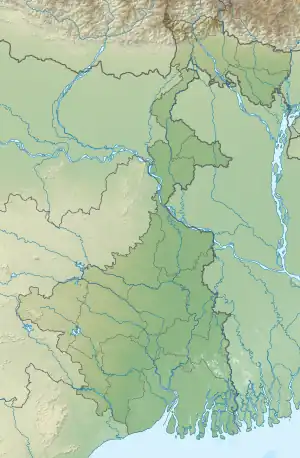 Shown within West Bengal | |
| Location | Bharatpur, West Bengal, India |
|---|---|
| Coordinates | 23°24′48″N 87°27′28″E / 23.4134°N 87.4578°E |
| Type | Settlement |
| History | |
| Founded | 1735–1417 BCE |
| Abandoned | 8th–9th centuries A.D. |
| Cultures | Early village farming culture |
| Events | not known |
| Site notes | |
| Condition | Ruined |
| Ownership | Public |
| Public access | Yes |
Bharatpur is an archaeological site of Early village farming culture located in the Indian state of West Bengal. Construction of the settlement is believed to have started around 1735–1417 BC.[1]
The prehistoric settlement at Bharatpur village was discovered in 1971 by the Eastern Circle of Archaeological Survey of India and the University of Burdwan. Excavations were carried out at Bharatpur in 1971–72, 1972–73, 1973–74 and 1974–75.[2] Black and red pottery, terracotta objects and cut bone weapons were discovered during the excavations.[1]
Archaeology
The Eastern Circle of Archaeological Survey of India and the University of Burdwan jointly undertook a program of survey exploration and excavation in the 1970s. These excavations proved the presence of ancient settlement.[3] Bharatpur was first excavated in 1971 and last in 1975, which establishing the archaeological site as a center of Bengal's early village farming culture.[1] This place is located 6 km (3.7 mi) from Panagarh on the north bank of Damodar river.
Archaeologists claim that the settlement was a center of the early village farming and the Black and Red Pottery culture of West Bengal. According to the carbon 14 dating of the samples obtained, Bharatpur is one of the archaeological settlements of early village farming culture discovered in West Bengal. More than 3700 years old specimens have been found from the archaeological site. Early village farming culture existed here from 1700 BCE, which was contemporary with the Pre-Harappan, Harappan and Post-Harappan periods.[1]
Excavated Bharatpur
Buddhist monastery and stupa have been discovered at Bharatpur during excavations.[4] Also, evidence of early agricultural communities has been found in the recovered samples.
Buddhist Stupa

The stupa was built between the 7th and 9th centuries during the Pala period. It was built in brick and stone in the Pancharatha style, with a base area of 13 square meters. Today, the base structure of the stupa survives, When the rest of the part was destroyed. Two different sizes of bricks are used in the construction, which are 30 x 8 x 7 cm and 48 x 21 x 6 cm respectively. The facades are embellished with corbelled courses, moldings and chaitya gavaksa motifs of floral designs. The niches of stupa were probably decorated with Buddha statues.[5][6][7] Eleven Buddha statues seated on Vajrasana in Bhumiparsha Mudras – all five fingers of the right hand extended to touch the ground – were discovered in this ruined stupa.[6]
References
- 1 2 3 4 Chattopadhyay et al. 2015, p. 240.
- ↑ "Excavations – Since Independence – West Bengal". asi.nic.in. Retrieved 1 October 2023.
- ↑ Ghosh, Shibshankar (2000). Gopbhumer Swarup, Aitijhya O Sanskriti. pp. 99–107. Retrieved 1 October 2023.
- ↑ Singh, Shiv Sahay (21 January 2023). "Of a bygone era: excavations reveal Buddhist monastery complex at Bharatpur of Bengal". www.thehindu.com. Kolkata: The Hindu. Retrieved 1 October 2023.
- ↑ Majumdar, Somreeta (1 January 2020). "Archaeological Landscape of the Buddhist Stupa of Bharatpur". Arnava. Visva-Bharati University: 54–55. Retrieved 1 October 2023.
- 1 2 Dutta, Shrabani (9 January 2019). "পশ্চিম বর্ধমানের বৌদ্ধ প্রত্নস্থল". www.anandabazar.com (in Bengali). Anandabazar Patrika. Retrieved 1 October 2023.
- ↑ Bhowmik, Rupam (9 February 2023). "Unearthing Bharatpur Stupa: A treasure trove of historical and cultural artifacts". Get Bengal. Retrieved 1 October 2023.
Bibliography
- Chattopadhyay, Rupendra Kumar; Bandyopadhyay, KumKum (1 December 2015). "A Preliminary Study of the Worked Bone Industry in the Middle and Lower Ganga Valleys: From the Mesolithic to the Early Historic Periods". Studies in South Asian Heritage: essays in memory of M Harunur Rashid. Bangla Academy. ISBN 9789840753833.
